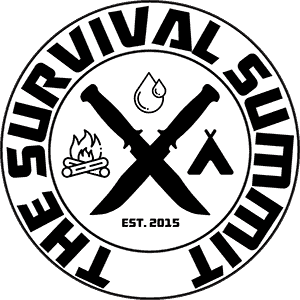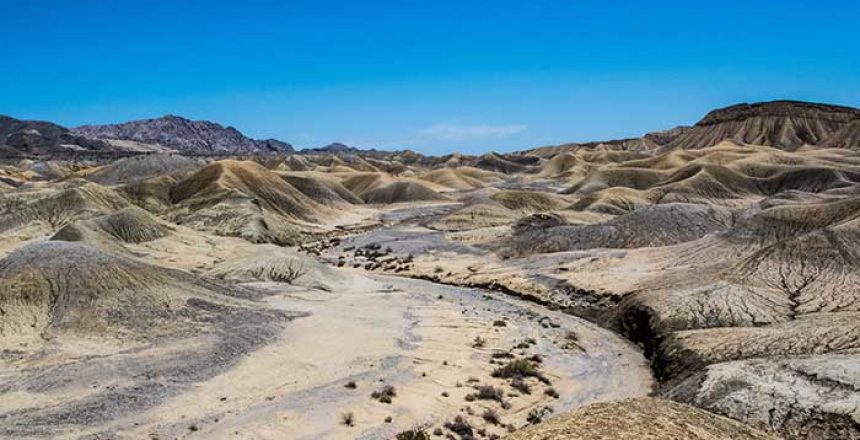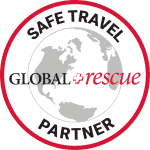Survival In The Desert
Editor’s note: This article is being republished with generous permission from Desert USA.
Desert Survival Skills
How to Survive in the Desert
by David Alloway
It’s unfortunate that many people equate deserts with a hostile environment that conspires against human life. In the popular media, desert areas seem to be considered at the top of the wilderness list for danger. The historical fact is, however, that the human race was cradled in arid lands and people are well adapted to survive in deserts. Learning to be part of the desert’s ecosystem is the first step of desert survival. My philosophy is not to fight the desert, but to become part of its ecosystem. Being prepared is an obvious benefit.
Preparation starts with how you dress. People stand upright and receive only 60% of the solar radiation that animals on all fours do. By adding a proper hat, with a wide brim and closed crown, the head and body are further protected. A common mistake made by new desert visitors is wearing shorts and sleeveless shirts. Loose fitting long sleeves and pants provide good air circulation and much better protection than sunblock.
Sunglasses that exclude ultra-violet light are a good idea, and some studies claim they can help prevent cataracts later. Other areas of preparation include proper vehicle maintenance, carrying sufficient water, first aid and survival kits for desert environments, a sturdy, sharp knife and some useful knowledge.
The Panic Factor
The biggest killer in any emergency situation is panic. Panic blinds a person to reason and can cause them to compound the emergency with fatal results. Controlling panic is a matter of focusing the mind and operating in an organized manner. My Australian counterpart, Bob Cooper, teaches the ABC’s of survival to ward off panic and start the person on a constructive course of action.
A: Accept the situation. Do not blame yourself or others. Do not waste time contemplating “What if I had…”
B: Brew up a cup of tea. This is a typical Aussie approach to the solution of everything. What you are actually doing is starting a fire, which is needed, and completing a familiar, calming chore. You can brew coffee or just build a fire.
C: Consider your options. Take stock of items at hand, such as water reserves, survival kits, etc.
D: Decide on a plan. Taking into account of your options, decide on a plan that best ensures your health and safety. Thoughts such as “I have to be at work tomorrow,” are not considered.
E. Execute the plan and stick with it unless new conditions warrant.
The brain is by far the best survival tool we have. Survival is much more a mental than a physical exercise, and keeping control of the brain is necessary. The large size of the human brain requires a high metabolic sacrifice in water and temperature control. Keeping the brain hydrated and in the shade will be more beneficial than all the gee-whiz survival gizmos in the sporting goods store.
An additional psychological factor is the will to survive. It may sound odd, but some people have just given up due to what they felt was hopelessness, impending pain, hunger, etc. In the lid of my survival kit I keep a photo of my two sons, ages 7 years and 22 months, as a reminder of who needs me.
Women should not be discouraged in these situations on the basis of their gender. Women have several physical advantages over men in high stress situations. I participated in a 200-kilometer survival trek in Western Australia in 1996 with two women in our group, and they did as well as the 7 men.
Survival Kits
I am a believer in a well-planned survival kit. In the Australian trek, each of us had a pocket-sized survival kit that fit in a soap dish. That, along with a knife, two one-liter canteens, a medical blanket and a compass each, we all crossed the finish line at the Indian Ocean. A survival kit must be small enough to carry at all times in the wilds. By cramming them full of unnecessary items they get too bulky and tend to get left in the car, backpack or elsewhere, which is the same as not having one at all. The contents of such a kit is at the end of this article. You’ll be surprised at what can fit in a 4x3x1-inch” box.
Desert Survival Priorities
While there are some exceptions to this rule, desert survival priorities usually fall in this order of importance.
Water
Deserts are defined by their lack of water. Learn to ration sweat, not water. By staying in the shade, limiting activity to cooler times such as night and using your available water, your chances for survival increase greatly. Sipping water does not get it to the brain and vital organs. Take a good drink when you need it. People have been found dead from dehydration with water in their canteens. Also, do not rely on “parlor tricks” such as solar stills as a primary source. These will often produce more sweat digging the hole than is obtained from water gained. Learn to locate water through areas of green vegetation, flights of birds, converging animal trails and digging in the outside bends of dry creek beds. Javelinas and burros are excellent at finding water and digging it up in creek beds. Best of all, plan ahead, and allow one gallon per person a day. This does not include your needs for cooking, pets or auto maintenance.
Fire
Fire may seem odd to have so high on the list of desert survival priorities, but there are considerations other than warmth, though a fire may also be needed for that reason. Fire can be used to signal, cook food and purify water. Fire also provides psychological comfort. People do not feel so lonely with a fire. It makes the night less frightening, and while there are few large animals dangerous to people in North American deserts, fire will keep them at bay. It is important to know how to start a fire under severe conditions with means other than matches. Friction methods such as the bow and drill take much practice and should be learned before they are needed.

Shelter
Aside from your clothes, additional shelter may be needed. In desert areas, shelter from the sun is usually the main consideration, but cold, rain, hail, even snow can also be factors. It is important to keep the skin temperature under 92 degrees F, to keep from sweating away precious water. Draping a sleeping bag over a bush for shade, while allowing for breezes, may be the best bet. Try not to sit on the hot ground, even if it means tearing the seats out of your brand new 4×4. Try to make shelter visible to searchers. Build shelter in a safe place, such as out of creek beds which can flash flood.
Signals
Signaling for help will hasten rescue. Signals, whether visible or audible, must be distinguished from nature. A signal mirror is best for sunny desert conditions and can be seen for miles. Flash at aircraft, dust clouds (which may be vehicles on dirt roads) and periodically scan the horizon. Burning a spare tire will put up a huge column of black smoke, but the tire must be punctured or have the valve core removed first to prevent it from exploding and injuring those nearby. Flares are good at night if there is reason to think they will be seen. Put the hood up on your car and tie a rag to the antennae. Wearing bright colored clothing will help aircraft see you better.
Audible signals should be made in rhythmic bursts of three. A long whistle blast sounds like a hawk from a distance, but 3 timed short blasts sound like a signal for help. Gunshots and car horns also should be timed in groups of three. Yelling is the poorest alternative. A whistle is a very good emergency item — especially for children, who may be frightened by strange noises at night. If the noise is caused by searchers, a whistle will bring them closer. If caused by animals, real or imagined, a whistle will scare them away.
Food
“What did you eat?” is the question I get the most about my Australian trek. Most people think of survival in terms of lack of food. In hot climates, however, food is not as important as other factors. If water is in short supply it is important not to eat anything because it increases your water needs to digest the food. On my Australian adventure I had a 6-inch perch, a handful of wattle seeds, and 6 cattail shoots.
I lost 20 pounds, but after day 3, I did not feel really hungry. Water was our biggest worry. Most people today can go 3 weeks without eating. I think more people are afraid of the pain of hunger than starvation.
The basics of desert survival? Prepare for the worst. Control panic. Use your brain. Use energy and water wisely. Be ready to signal. Don’t listen to your stomach. Most of all, do not fear the desert. For many of us, it is home.
Photos courtesy John Babb and Big Bend Ranch State Park
SURVIVAL OFF-ROAD DRIVING
What to do when you get lost, stuck, or if your car breaks down.
Stay with your vehicle or otherwise make yourself visible. Keep calm — don’t panic and don’t waste time on the ‘if’ word (‘If only I hadn’t done that.’) It’s wasted effort, you did it, or it happened, whatever. Spend your time constructively.
Think through your options. Take stock of your supplies and situation.
Stay put, unless you have a clear and specific destination. If you choose to hike out, avoid walking during the heat of the day; morning and evening walking is better for conserving your body’s moisture. If you must leave your vehicle, leave a note telling the direction of your travel, your destination, and the date and time you left. Here’s what can happen if you leave your car.
Seek shelter from the elements, but try to make yourself visible (with smoke or a signal fire, or a brightly colored tarp).
More information on desert driving.
Contents Of Author’s Pocket Survival Kit
Soap dish container
1 Mark III knife
1 strip magnifier
1 signal mirror
1 flint striker
1 small lighter (childproof to prevent leaking)
1 Tweezers
Fishhooks & sinkers
Snare wire
Fishing line
1 large needle
Cord
1 pencil stub
2 bouillon cubes
1 water tight plastic bag
to store items that need to be kept dry
Sterile scalpel blade
Sugar tablets
1 vial potassium permanganate – Used for water purification, anti-septic, anti-fungal. When mixed with crushed sugar tablet, it can be friction ignited to start a fire.
1 signal whistle
1Mini-Mag® flashlight and spare AAA battery
1 button compass
1 tea bag – Use black tea cooled
down for sunburn relief.
2 alcohol wipes – Besides being antiseptic,
they will ignite with sparks from flint striker
3 Band-Aids
2 plastic bags
ADD: Benadryl, Tylenol and any other personal medications needed
Read more: http://www.desertusa.com/desert-activity/desert-survival-skills.html#ixzz4GT0Usiet






4 thoughts on “Survival In The Desert”
Great article!
I admire all the people in this field/activity who share so much of their knowledge
and experience; and encourage others to get going and get involved.
I appreciate that I was able to print all of it including the photos.
This is, and has been a terrific site.
I am consistently amazed to find people who have not done any kind
of emergency planning or even put together a basic vehicle emergency kit.
Thank you
Thanks for your kind words Ed! We try our best to keep it current, and really push great content, even at the risk of "slowly" releasing content. We strive to be the best, and I hope to someday be there! Thanks again for your feedback!
If you have the knowledge to survive year round in the desert you have 90-95% of the knowledge needed to survive anywhere.
I agree!
Comments are closed.